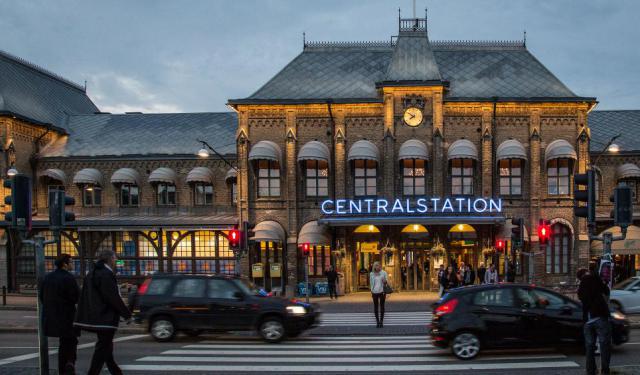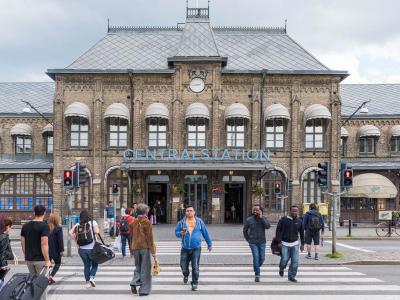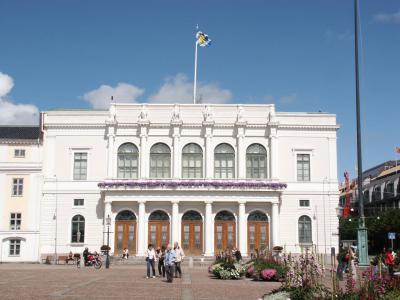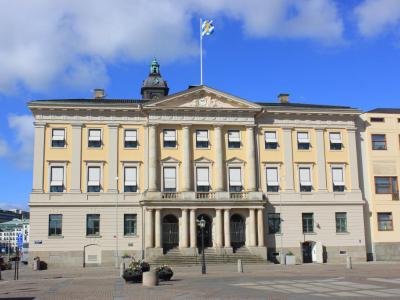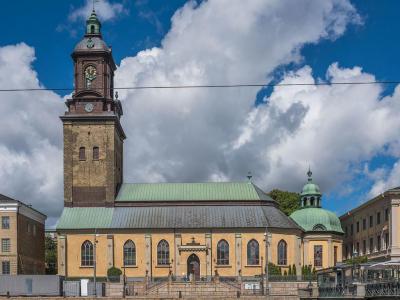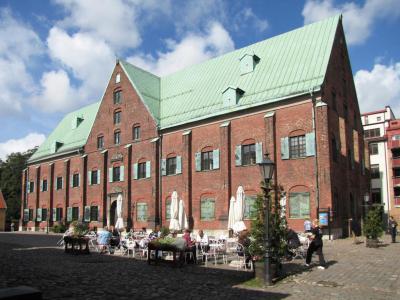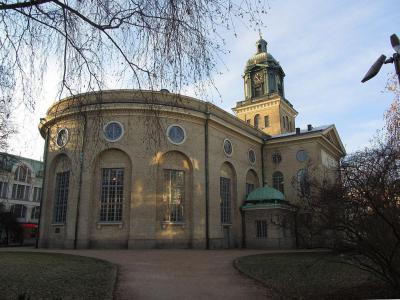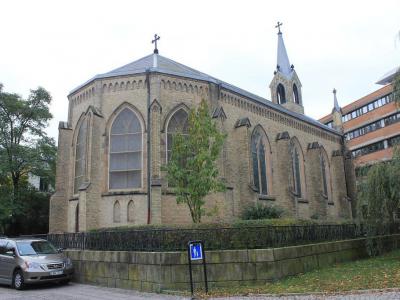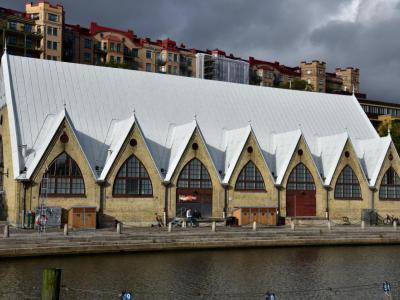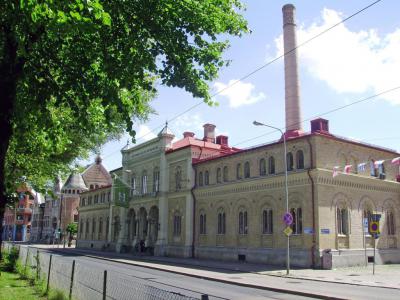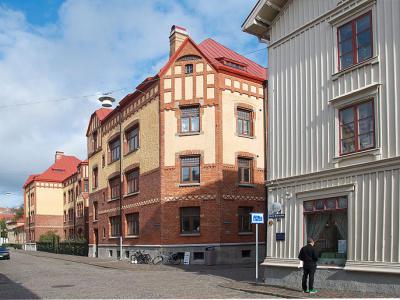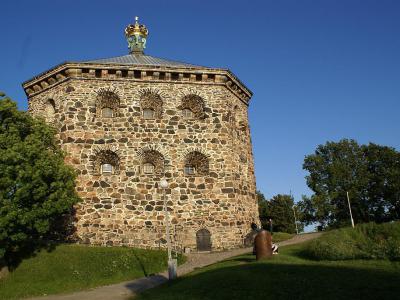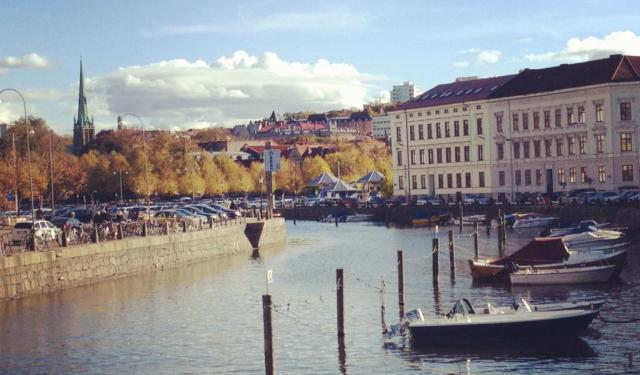Historical Buildings Walking Tour (Self Guided), Gothenburg
Like the majority of Swedish cities, Gothenburg is constantly re-inventing itself whilst continuing to celebrate its past. The latter is no more evident than in the city’s stunning historic architecture, manifested in a wonderful collection of stately old buildings, carefully preserved amid the relatively new ones.
Gothenburg’s architecture comes in a wide range of styles, from Gothic to Modernist, including several 17th-century buildings made of wood and great classical structures from the 18th century. In the past, series of fires had destroyed many local houses in various stages, leaving to survive only a handful of them, such as the Kronhuset (Crown House) in Gustaf Adolfs torg (square). This Dutch-style building is now one of the oldest in the city, completed in 1654, and was originally a storehouse for military equipment; today used as a concert hall.
Another remnant of the past is the City Hall, completed in 1672. Eventually considered too small for its purpose, it was extended in 1936 with a functional addition by architect Gunnar Asplund, whose way of blending the old with the new received international acclaim.
Gothenburg Cathedral, located in the city center, is the third cathedral on this site. The first one, opened in 1633, burned down in 1721; the second one, built in 1722, also perished in fire in 1802. The third and current building dates back to 1825, although it wasn't completely finished until twelve years later.
Speaking of the old-timers, one shouldn't forget the Skansen Kronan (Crown Sconce) fortress upon the Risåsberget hill in Haga neighborhood; completed in 1689, it offers a spectacular view of the city.
Among other, more modern architectural highlights of Gothenburg are: the Central Station, rebuilt a number of times since its inauguration in 1858; the Feskekôrka (“Fish Church”) fish market, completed in 1873 – here you can buy fresh fish and seafood straight off the docks; and the Hagabadet (Haga Baths), a Jugendstil building from 1876, partially burned down in 1903 and rebuilt.
If you're an architecture-buff or simply has an eye for all things beautiful, take this self-guided walking tour for a chance to admire these and other historic buildings of Gothenburg in their splendor.
Gothenburg’s architecture comes in a wide range of styles, from Gothic to Modernist, including several 17th-century buildings made of wood and great classical structures from the 18th century. In the past, series of fires had destroyed many local houses in various stages, leaving to survive only a handful of them, such as the Kronhuset (Crown House) in Gustaf Adolfs torg (square). This Dutch-style building is now one of the oldest in the city, completed in 1654, and was originally a storehouse for military equipment; today used as a concert hall.
Another remnant of the past is the City Hall, completed in 1672. Eventually considered too small for its purpose, it was extended in 1936 with a functional addition by architect Gunnar Asplund, whose way of blending the old with the new received international acclaim.
Gothenburg Cathedral, located in the city center, is the third cathedral on this site. The first one, opened in 1633, burned down in 1721; the second one, built in 1722, also perished in fire in 1802. The third and current building dates back to 1825, although it wasn't completely finished until twelve years later.
Speaking of the old-timers, one shouldn't forget the Skansen Kronan (Crown Sconce) fortress upon the Risåsberget hill in Haga neighborhood; completed in 1689, it offers a spectacular view of the city.
Among other, more modern architectural highlights of Gothenburg are: the Central Station, rebuilt a number of times since its inauguration in 1858; the Feskekôrka (“Fish Church”) fish market, completed in 1873 – here you can buy fresh fish and seafood straight off the docks; and the Hagabadet (Haga Baths), a Jugendstil building from 1876, partially burned down in 1903 and rebuilt.
If you're an architecture-buff or simply has an eye for all things beautiful, take this self-guided walking tour for a chance to admire these and other historic buildings of Gothenburg in their splendor.
How it works: Download the app "GPSmyCity: Walks in 1K+ Cities" from Apple App Store or Google Play Store to your mobile phone or tablet. The app turns your mobile device into a personal tour guide and its built-in GPS navigation functions guide you from one tour stop to next. The app works offline, so no data plan is needed when traveling abroad.
Historical Buildings Walking Tour Map
Guide Name: Historical Buildings Walking Tour
Guide Location: Sweden » Gothenburg (See other walking tours in Gothenburg)
Guide Type: Self-guided Walking Tour (Sightseeing)
# of Attractions: 11
Tour Duration: 2 Hour(s)
Travel Distance: 3.3 Km or 2.1 Miles
Author: DanaOffice
Sight(s) Featured in This Guide:
Guide Location: Sweden » Gothenburg (See other walking tours in Gothenburg)
Guide Type: Self-guided Walking Tour (Sightseeing)
# of Attractions: 11
Tour Duration: 2 Hour(s)
Travel Distance: 3.3 Km or 2.1 Miles
Author: DanaOffice
Sight(s) Featured in This Guide:
- Gothenburg Central Station
- The Bourse
- Gothenburg City Hall
- Tyska Kyrkan (German Church)
- Kronhuset (Crown House)
- Gothenburg Cathedral
- St. Andrew's Church
- Feskekôrka (Fish Church)
- Hagabadet (Haga Baths)
- Robert Dickson Foundation
- Skansen Kronan (Crown Sconce)
1) Gothenburg Central Station
The Gothenburg Central Station serves as the primary railway hub in Gothenburg, being the third largest of its kind in Sweden. Initially erected between 1856 and 1857 on the site of a former prison, the original structure featured a spacious entrance hall, two waiting areas, and several dining establishments. In 1923, a reconstruction and expansion project, led by architect Folke Zettervall, the official SJ architect at the time, was undertaken. Unfortunately, a fire on March 14, 1923, ravaged significant portions of the station. Subsequently, from 1928 to 1930, further enlargement occurred due to increased traffic demands. Later modifications included the construction of a new restaurant facing Drottningtorget.
In 1993, efforts were made to restore the Central Station, with additional renovations taking place between 2000 and 2003, resulting in the addition of the Central House extension. Presently, the interior design mirrors that of the 1923 model, featuring wooden pillars, a glass ceiling, and a limestone floor. Notably, in the 1940s, there was consideration to demolish the waiting hall; however, its preservation was deemed necessary due to its adornment with paintings by artist Filip Månsson. Despite the inability to salvage the original paintings, the decision was made to retain the hall.
During the 19th and early 20th centuries, approximately one million Swedish emigrants traversed through the station en route to the harbor, with their ultimate destination being America.
In 1993, efforts were made to restore the Central Station, with additional renovations taking place between 2000 and 2003, resulting in the addition of the Central House extension. Presently, the interior design mirrors that of the 1923 model, featuring wooden pillars, a glass ceiling, and a limestone floor. Notably, in the 1940s, there was consideration to demolish the waiting hall; however, its preservation was deemed necessary due to its adornment with paintings by artist Filip Månsson. Despite the inability to salvage the original paintings, the decision was made to retain the hall.
During the 19th and early 20th centuries, approximately one million Swedish emigrants traversed through the station en route to the harbor, with their ultimate destination being America.
2) The Bourse
The Bourse (Börsen) is a historic building in Gothenburg, situated on the north side of Gustaf Adolf Square. Designed in the Neoclassical style by architect Pehr Johan Ekman, it was inaugurated on December 1, 1849, initially serving as a marketplace rather than a stock exchange, despite its name's translation. The term "Börsen," influenced by the French "La bourse," more accurately reflects its role as a commercial exchange, akin to modern commodities exchanges.
Its significance in Gothenburg's civic life is evident as it has been the meeting place for the Gothenburg Municipal Council since January 5, 1863, continuing a tradition of governance that predates its construction. This tradition aligns with Gothenburg's commercial history, highlighted by the establishment of Sweden's first trade guild in 1661, which met in a town hall on the site now occupied by Gustaf Adolf Square.
The Bourse replaced the Kaulbarska House, owned by Baron Johan von Kaulbars, a general in King Charles XII's army, which stood on the land previously. The construction was funded by the city's merchants, with King Oscar I laying the cornerstone on June 1, 1844. Completed five years later, the building symbolized the economic vitality of Gothenburg's merchant community.
Aside from its historical and architectural significance, the Bourse has served as a crucial venue for municipal meetings, highlighting its importance in Gothenburg's civic life. Recent renovations, undertaken between 2014 and 2019, restored the building's integrity and facilitated the return of the municipal council to its historic meeting place, emphasizing the enduring significance of the Bourse in Gothenburg's social and political landscape.
Its significance in Gothenburg's civic life is evident as it has been the meeting place for the Gothenburg Municipal Council since January 5, 1863, continuing a tradition of governance that predates its construction. This tradition aligns with Gothenburg's commercial history, highlighted by the establishment of Sweden's first trade guild in 1661, which met in a town hall on the site now occupied by Gustaf Adolf Square.
The Bourse replaced the Kaulbarska House, owned by Baron Johan von Kaulbars, a general in King Charles XII's army, which stood on the land previously. The construction was funded by the city's merchants, with King Oscar I laying the cornerstone on June 1, 1844. Completed five years later, the building symbolized the economic vitality of Gothenburg's merchant community.
Aside from its historical and architectural significance, the Bourse has served as a crucial venue for municipal meetings, highlighting its importance in Gothenburg's civic life. Recent renovations, undertaken between 2014 and 2019, restored the building's integrity and facilitated the return of the municipal council to its historic meeting place, emphasizing the enduring significance of the Bourse in Gothenburg's social and political landscape.
3) Gothenburg City Hall
Gothenburg City Hall stands as a complex situated at Gustaf Adolf's Square. It comprises an older segment, finalized in 1672 and crafted by Nicodemus Tessin, alongside a newer addition completed in 1936, designed by architect Gunnar Asplund.
The inception of a permanent stone town hall commenced in the mid-1660s, evidenced by foundation walls, possibly intended for a residence, on the site. Nicodemus Tessin, the Elder, was tasked with the design of the new edifice. After adjustments, the architectural blueprints were finalized by 1670. Construction was initiated in 1668 under the supervision of master mason L. Olofsson from Stockholm. By the summer of 1672, the section facing Stora Hamnkanalen was completed, with the entire structure subsequently plastered and "brushed."
As time progressed, the town hall proved inadequate in size, prompting discussions regarding expansion as early as 1885. However, it wasn't until October 22, 1936, that the scaffolding came down, revealing the sleek, functionalist extension, commonly referred to as the Asplund extension. Internally, it features a luminous town hall space with a glass facade overlooking the city. The extension is adorned with Eric Grate's relief series "The Four Winds" (1937–1941).
Historically, the town hall accommodated the former city council of Gothenburg, later transitioning to house the Gothenburg town hall court and portions of the Gothenburg district court. On February 15, 2010, the district court relocated to Rättscentrum Göteborg on Ullevigatan 15, leaving the building vacant until 2012 when it underwent renovation and transformation into Gothenburg City Hall. The reopening ceremony occurred on April 13, 2014, presided over by the municipal board chair, Anneli Hultén. Presently, it serves as the administrative hub for both municipal and city management.
Designated as a listed building on October 24, 1968, and again on October 25, 1982, Gothenburg City Hall is owned by the municipality of Gothenburg and overseen by Higab.
The inception of a permanent stone town hall commenced in the mid-1660s, evidenced by foundation walls, possibly intended for a residence, on the site. Nicodemus Tessin, the Elder, was tasked with the design of the new edifice. After adjustments, the architectural blueprints were finalized by 1670. Construction was initiated in 1668 under the supervision of master mason L. Olofsson from Stockholm. By the summer of 1672, the section facing Stora Hamnkanalen was completed, with the entire structure subsequently plastered and "brushed."
As time progressed, the town hall proved inadequate in size, prompting discussions regarding expansion as early as 1885. However, it wasn't until October 22, 1936, that the scaffolding came down, revealing the sleek, functionalist extension, commonly referred to as the Asplund extension. Internally, it features a luminous town hall space with a glass facade overlooking the city. The extension is adorned with Eric Grate's relief series "The Four Winds" (1937–1941).
Historically, the town hall accommodated the former city council of Gothenburg, later transitioning to house the Gothenburg town hall court and portions of the Gothenburg district court. On February 15, 2010, the district court relocated to Rättscentrum Göteborg on Ullevigatan 15, leaving the building vacant until 2012 when it underwent renovation and transformation into Gothenburg City Hall. The reopening ceremony occurred on April 13, 2014, presided over by the municipal board chair, Anneli Hultén. Presently, it serves as the administrative hub for both municipal and city management.
Designated as a listed building on October 24, 1968, and again on October 25, 1982, Gothenburg City Hall is owned by the municipality of Gothenburg and overseen by Higab.
4) Tyska Kyrkan (German Church)
The German Church (Tyska Kyrkan) or Christian Church (Christinenkirche) is a significant landmark situated on Norra Hamngatan in the vibrant center of Gothenburg. It holds historical and architectural importance, serving the German Christinae parish without being confined to a specific territory, thus making a notable cultural and religious impact in the city. Named after Queen Christina, daughter of King Gustav II Adolf, it reflects the enduring historical connections and respect for the Swedish monarchy. Officially opened in 1748, it has become a crucial place of worship for both German and Dutch congregations residing in Gothenburg.
The church's main structure, constructed from yellow brick and adorned with yellow plaster, stands out with its welcoming appearance. Designed by Carl Fredrik Adelcrantz, a renowned architect from Stockholm known for his work on notable buildings like the Drottningholm Theater and parts of Stockholm's Castle, the church holds significance in Sweden's architectural heritage.
Noteworthy features include the tower, separate from the main building, and the chancel, meticulously designed to harmonize with the cityscape. Inside, the altarpiece by Louis Jean Desprez and the chancel windows by Reinhold Callmander add artistic and spiritual dimensions to the worship space.
A highlight of the church is its carillon, installed in 1961, boasting 42 bells, including one with a rich history dating back to 1687. This bell, along with others recast after a fire in 1746, contributes to the church's auditory landscape, echoing through Gothenburg's streets and calling worshippers to prayer. The involvement of figures like Governor Nils Assersson Mannersköld and Admiral Martin Anckarhjelm in the carillon's history underscores the community's enduring support for the church.
The church's main structure, constructed from yellow brick and adorned with yellow plaster, stands out with its welcoming appearance. Designed by Carl Fredrik Adelcrantz, a renowned architect from Stockholm known for his work on notable buildings like the Drottningholm Theater and parts of Stockholm's Castle, the church holds significance in Sweden's architectural heritage.
Noteworthy features include the tower, separate from the main building, and the chancel, meticulously designed to harmonize with the cityscape. Inside, the altarpiece by Louis Jean Desprez and the chancel windows by Reinhold Callmander add artistic and spiritual dimensions to the worship space.
A highlight of the church is its carillon, installed in 1961, boasting 42 bells, including one with a rich history dating back to 1687. This bell, along with others recast after a fire in 1746, contributes to the church's auditory landscape, echoing through Gothenburg's streets and calling worshippers to prayer. The involvement of figures like Governor Nils Assersson Mannersköld and Admiral Martin Anckarhjelm in the carillon's history underscores the community's enduring support for the church.
5) Kronhuset (Crown House)
The Crown House (Kronhuset) is a prominent redbrick structure in Västra Nordstaden, Gothenburg. Its construction, spanning from 1643 to 1654, aligns it as one of Gothenburg's oldest secular buildings, sharing this honor with the Torstenson Palace. Simon de la Vallée, a notable royal architect, is credited with its design, characterized by Dutch architectural influences.
Originally serving as an arsenal for the city garrison and a granary to safeguard food supplies during sieges, the Crown House transitioned from state ownership to that of Gothenburg Municipality in 1927. Its historical significance led to its listing as a protected building in 1968.
The architectural features of the Crown House are distinctive, showcasing Dutch influences, particularly evident in the Rikssal (national hall) on the ground floor. Notably, the absence of load-bearing pillars in the Rikssal is a testament to the innovative construction techniques employed during its era. Additionally, the Flemish tapestry, dating back to around 1690, adds to the building's cultural heritage.
Over the centuries, the Crown House underwent modifications, including window alterations and the installation of wooden emblems, possibly salvaged from the demolished Kungsporten, during the 18th and 19th centuries, respectively.
Adjacent to Crown House are the Crown House sheds (Kronhusbodarna), eighteenth-century structures painted in vibrant yellow hues, encircling the courtyard. Recognized as listed buildings since 1968, these sheds now accommodate various shops and tenants, offering pottery, glassware, leather products, interior furnishings, a watchmaker, and a cafe. Moreover, an annual arts and crafts market held in the courtyard has become a tradition since the early 2000s.
At the rear of the sheds lies the Crown Park (Kronhusparken), a small park established in 1930 and renovated in 1964 following its acquisition by the city. Covering approximately 2000 square meters, the park features a bust of the poet Johan Anders Wadman, sculpted by Johan Peter Molin, commemorating his residency in Gothenburg from 1814 to 1838.
Originally serving as an arsenal for the city garrison and a granary to safeguard food supplies during sieges, the Crown House transitioned from state ownership to that of Gothenburg Municipality in 1927. Its historical significance led to its listing as a protected building in 1968.
The architectural features of the Crown House are distinctive, showcasing Dutch influences, particularly evident in the Rikssal (national hall) on the ground floor. Notably, the absence of load-bearing pillars in the Rikssal is a testament to the innovative construction techniques employed during its era. Additionally, the Flemish tapestry, dating back to around 1690, adds to the building's cultural heritage.
Over the centuries, the Crown House underwent modifications, including window alterations and the installation of wooden emblems, possibly salvaged from the demolished Kungsporten, during the 18th and 19th centuries, respectively.
Adjacent to Crown House are the Crown House sheds (Kronhusbodarna), eighteenth-century structures painted in vibrant yellow hues, encircling the courtyard. Recognized as listed buildings since 1968, these sheds now accommodate various shops and tenants, offering pottery, glassware, leather products, interior furnishings, a watchmaker, and a cafe. Moreover, an annual arts and crafts market held in the courtyard has become a tradition since the early 2000s.
At the rear of the sheds lies the Crown Park (Kronhusparken), a small park established in 1930 and renovated in 1964 following its acquisition by the city. Covering approximately 2000 square meters, the park features a bust of the poet Johan Anders Wadman, sculpted by Johan Peter Molin, commemorating his residency in Gothenburg from 1814 to 1838.
6) Gothenburg Cathedral
A church has stood on this site since the early 1600s. The initial small rectory was Gothenburg's first church and one of the new city's first buildings. Construction on the first cathedral began in 1626 and was completed in 1633. The church was designated as a cathedral in the 1680s.
Gothenburg Cathedral burned during a fire on April 15, 1721. However, the original walls survived the fire, and officials quickly rebuilt the cathedral. The cathedral was rebuilt with the same dimensions and reopened on May 25, 1722. Renovations and upgrades continued with a new copper roof and tower capital.
Another terrible fire burned the cathedral on December 20, 1802. This fire also destroyed 179 houses in addition to the cathedral's cemetery. The cathedral was so damaged that a complete rebuild was necessary. The current cathedral was completed in 1815. The tower was built in 1825, and its copper cladding was complete in time for the second inauguration in 1827.
The current cathedral features classical architecture. The impressive main portal features four Doric columns. The interior features classical and Empire style. Many interior fittings, including the pulpit, feature Empire-style white and gold leaves.
The cathedral has classical-style ionic pilasters. The altar's 18th-century angelic figures feature Baroque styling. Gothenburg Cathedral was Sweden's first church to have central heating in 1852.
The cathedral's grandfather clock was built in 1751 and survived the 1802 fire. The organ was made 1962 but features a traditional white and gold facade. The cathedral's tower began to lean in the early 20th century and was reinforced.
Gothenburg Cathedral burned during a fire on April 15, 1721. However, the original walls survived the fire, and officials quickly rebuilt the cathedral. The cathedral was rebuilt with the same dimensions and reopened on May 25, 1722. Renovations and upgrades continued with a new copper roof and tower capital.
Another terrible fire burned the cathedral on December 20, 1802. This fire also destroyed 179 houses in addition to the cathedral's cemetery. The cathedral was so damaged that a complete rebuild was necessary. The current cathedral was completed in 1815. The tower was built in 1825, and its copper cladding was complete in time for the second inauguration in 1827.
The current cathedral features classical architecture. The impressive main portal features four Doric columns. The interior features classical and Empire style. Many interior fittings, including the pulpit, feature Empire-style white and gold leaves.
The cathedral has classical-style ionic pilasters. The altar's 18th-century angelic figures feature Baroque styling. Gothenburg Cathedral was Sweden's first church to have central heating in 1852.
The cathedral's grandfather clock was built in 1751 and survived the 1802 fire. The organ was made 1962 but features a traditional white and gold facade. The cathedral's tower began to lean in the early 20th century and was reinforced.
7) St. Andrew's Church
Saint Andrew's Church in Gothenburg represents a strong tie between the Church of England and the city's international residents. Built in 1857, it has been a spiritual hub for the Church of England community in Gothenburg for generations. Its history traces back to 1747 when foreigners in the city could register life events with the Gothenburg English Parish until 1883. Initially, congregants gathered in a local house for services led by an English priest before establishing a permanent place of worship.
Designed by Swedish architect Adolf Wilhelm Edelsvard, the church boasts a striking Neo-Gothic facade made of yellow brick and sandstone, giving it a unique character. The construction was a joint effort, funded equally by the Church of England and local parishioners, showing their shared dedication to creating a space for worship and community.
Noteworthy are the stained glass windows, crafted in Scotland, depicting biblical figures like Matthew, Mark, Paul, Peter, and John, adding to the church's beauty and religious significance. The church also houses a 14-stop organ inaugurated in 1862, adding to its cultural and spiritual allure.
Today, Saint Andrew's Church remains a lively hub for Gothenburg's English-speaking community, hosting services in English every Sunday. This enduring tradition ensures the church remains a welcoming place for worship and community for locals and expatriates, preserving its historical importance while serving its diverse congregation's spiritual needs.
Designed by Swedish architect Adolf Wilhelm Edelsvard, the church boasts a striking Neo-Gothic facade made of yellow brick and sandstone, giving it a unique character. The construction was a joint effort, funded equally by the Church of England and local parishioners, showing their shared dedication to creating a space for worship and community.
Noteworthy are the stained glass windows, crafted in Scotland, depicting biblical figures like Matthew, Mark, Paul, Peter, and John, adding to the church's beauty and religious significance. The church also houses a 14-stop organ inaugurated in 1862, adding to its cultural and spiritual allure.
Today, Saint Andrew's Church remains a lively hub for Gothenburg's English-speaking community, hosting services in English every Sunday. This enduring tradition ensures the church remains a welcoming place for worship and community for locals and expatriates, preserving its historical importance while serving its diverse congregation's spiritual needs.
8) Feskekôrka (Fish Church)
Don't be fooled by its name, Fish Church is not a church, but rather an indoor fish market housed in a building that looks like a Neo-Gothic church. Fish Church opened in 1874 to house the city's vibrant fish trade. Fishing is one of Gothenburg's oldest and most enduring trades. Visitors can buy fish that was swimming in the sea just a few hours earlier.
The market features fish, shellfish, and crustaceans. Vendors also serve ready-to-eat snacks and prepared dishes. In addition to the fish market, Fish Church houses a seafood restaurant. The restaurant has outdoor seating with a view of the Rosenlunds Canal.
Swedish architect Victor von Gegerfelt designed Fish Church. At the time, this building was considered futuristic. The interior's large hall doesn't have supporting pillars or walls as the roof's substructure provides the building's support. The building was originally called Fish Hall. However, residents quickly renamed it due to its resemblance to a church.
The market features fish, shellfish, and crustaceans. Vendors also serve ready-to-eat snacks and prepared dishes. In addition to the fish market, Fish Church houses a seafood restaurant. The restaurant has outdoor seating with a view of the Rosenlunds Canal.
Swedish architect Victor von Gegerfelt designed Fish Church. At the time, this building was considered futuristic. The interior's large hall doesn't have supporting pillars or walls as the roof's substructure provides the building's support. The building was originally called Fish Hall. However, residents quickly renamed it due to its resemblance to a church.
9) Hagabadet (Haga Baths)
Hagabadet is a historical bathing facility located in the Haga district of Gothenburg, which dates back to the 1870s. Recognized for its significant social and historical value, it was officially designated as a listed building on August 25, 1997.
Originally known as the Renströmska Bath and Laundry Institution, it was established in 1869 following a generous donation by Sven Renström to the city of Gothenburg. The primary aim was to promote good health, hygiene, and overall well-being. Designed by Axel Kumlien with assistance from city architect Victor von Gegerfelt, the construction of the facility was overseen by Professor Carl Curman, a leading expert in balneology at the time. It was officially inaugurated on December 9, 1876, featuring both basic and upscale bathing sections.
Unfortunately, a portion of the building was destroyed by fire in 1903, leading to its reconstruction according to plans by Wilhelm Klemming. This renovation included the addition of a large swimming pool. However, as time passed, the premises were deemed too confined, and with the opening of the modern Valhallabadet in 1956, the Renströmska facility was closed. Subsequently, it served various purposes such as a theater, workshop, and venue for club events.
In the 1970s, as part of a conservation initiative for the Haga district, efforts were made to preserve the historical significance of the bathhouse. Following its reopening in 1997 under the name Hagabadet, the establishment expanded its offerings to include wellness, spa treatments, conference facilities, and a restaurant, alongside its traditional bathing facilities.
Originally known as the Renströmska Bath and Laundry Institution, it was established in 1869 following a generous donation by Sven Renström to the city of Gothenburg. The primary aim was to promote good health, hygiene, and overall well-being. Designed by Axel Kumlien with assistance from city architect Victor von Gegerfelt, the construction of the facility was overseen by Professor Carl Curman, a leading expert in balneology at the time. It was officially inaugurated on December 9, 1876, featuring both basic and upscale bathing sections.
Unfortunately, a portion of the building was destroyed by fire in 1903, leading to its reconstruction according to plans by Wilhelm Klemming. This renovation included the addition of a large swimming pool. However, as time passed, the premises were deemed too confined, and with the opening of the modern Valhallabadet in 1956, the Renströmska facility was closed. Subsequently, it served various purposes such as a theater, workshop, and venue for club events.
In the 1970s, as part of a conservation initiative for the Haga district, efforts were made to preserve the historical significance of the bathhouse. Following its reopening in 1997 under the name Hagabadet, the establishment expanded its offerings to include wellness, spa treatments, conference facilities, and a restaurant, alongside its traditional bathing facilities.
10) Robert Dickson Foundation
The Robert Dickson Foundation is a Swedish housing organization established in Gothenburg in 1860 through the efforts of industrialist and philanthropist Robert Dickson (1782–1858). Operating to this day, the foundation manages 900 rental apartments.
Initially, on December 17, 1847, the city magistrate approved plans for two types of houses drawn by the city architect Heinrich Kaufmann. By July 1849, 10 single-story houses were completed and rented out (later demolished in 1896). As demand grew with applications from 39 households, the board sought additional land for more housing.
On May 16, 1856, additional plots were allocated to the board. They promptly decided to construct buildings on one of the plots, with architect Adolf W. Edelsvärd commissioned to design suitable stone structures, along with cost estimates. These plans gained approval from the magistrate on September 5, 1856.
Generous donations from Robert Dickson and his sons during the 1850s facilitated the construction of new homes, primarily targeting the working class. These buildings were constructed in red brick, reflecting a Neoclassical revival style.
Following discussions among the workers' housing boards and Carl Johan's parish, a proposal for the establishment of the Robert Dickson Foundation was formulated and later approved by King Maj on July 31, 1860.
Initially, on December 17, 1847, the city magistrate approved plans for two types of houses drawn by the city architect Heinrich Kaufmann. By July 1849, 10 single-story houses were completed and rented out (later demolished in 1896). As demand grew with applications from 39 households, the board sought additional land for more housing.
On May 16, 1856, additional plots were allocated to the board. They promptly decided to construct buildings on one of the plots, with architect Adolf W. Edelsvärd commissioned to design suitable stone structures, along with cost estimates. These plans gained approval from the magistrate on September 5, 1856.
Generous donations from Robert Dickson and his sons during the 1850s facilitated the construction of new homes, primarily targeting the working class. These buildings were constructed in red brick, reflecting a Neoclassical revival style.
Following discussions among the workers' housing boards and Carl Johan's parish, a proposal for the establishment of the Robert Dickson Foundation was formulated and later approved by King Maj on July 31, 1860.
11) Skansen Kronan (Crown Sconce)
The Crown Sconce (Skansen Kronan) stands in the Haga district of Gothenburg. It, along with its counterpart Skansen Lejonet, was constructed to defend Gothenburg from potential Danish attacks, similar to the purpose of the nearby sea fort, New Älvsborg.
Gothenburg was established in 1621 and fortified with an impressive system of defenses. However, military strategists were concerned about two hills, Gullberg and Risåsberg, overlooking the city. To counter this vulnerability, forts were built atop both hills. Designed by Erik Dahlbergh, the Crown Sconce sits atop Risåsberg while Skansen Lejonet occupies Gullberg.
Construction on Crown Sconce began in 1687, officially completed in 1698 with 23 guns installed, though the roof wasn't finished until 1700. Its formidable walls, made of granite, gneiss, and diabase, measure 4-5 meters thick. Despite its readiness, the fortress never faced attack, and its cannons remained silent.
In the early 1900s, the decision was made to repurpose the fortress as a military museum, which opened in November 1904. The museum closed in September 2004, transferring its collections to the Museum of Gothenburg. The Crown Sconce received protected status as a listed building in 1935.
Originally outside the city walls, the Crown Sconce is now nestled within the urban fabric of Haga in Gothenburg's west-central area. Today, it's privately owned and serves as a venue for conferences and private events. Beyond its historical significance, the old fortress provides panoramic views of the city.
Gothenburg was established in 1621 and fortified with an impressive system of defenses. However, military strategists were concerned about two hills, Gullberg and Risåsberg, overlooking the city. To counter this vulnerability, forts were built atop both hills. Designed by Erik Dahlbergh, the Crown Sconce sits atop Risåsberg while Skansen Lejonet occupies Gullberg.
Construction on Crown Sconce began in 1687, officially completed in 1698 with 23 guns installed, though the roof wasn't finished until 1700. Its formidable walls, made of granite, gneiss, and diabase, measure 4-5 meters thick. Despite its readiness, the fortress never faced attack, and its cannons remained silent.
In the early 1900s, the decision was made to repurpose the fortress as a military museum, which opened in November 1904. The museum closed in September 2004, transferring its collections to the Museum of Gothenburg. The Crown Sconce received protected status as a listed building in 1935.
Originally outside the city walls, the Crown Sconce is now nestled within the urban fabric of Haga in Gothenburg's west-central area. Today, it's privately owned and serves as a venue for conferences and private events. Beyond its historical significance, the old fortress provides panoramic views of the city.
Walking Tours in Gothenburg, Sweden
Create Your Own Walk in Gothenburg
Creating your own self-guided walk in Gothenburg is easy and fun. Choose the city attractions that you want to see and a walk route map will be created just for you. You can even set your hotel as the start point of the walk.
Gothenburg Introduction Walking Tour
Gothenburg is Sweden’s second-largest city. Its river-side location has been vital in its development from a trading colony to a modern, vibrant city. Today, Gothenburg is known for its culture, fabulous cuisine, and international flair.
Gothenburg was founded in 1621 by King Gustavus Adolphus. The king gave generous tax cuts to Dutch allies and encouraged German and Scottish residents to... view more
Tour Duration: 2 Hour(s)
Travel Distance: 2.7 Km or 1.7 Miles
Gothenburg was founded in 1621 by King Gustavus Adolphus. The king gave generous tax cuts to Dutch allies and encouraged German and Scottish residents to... view more
Tour Duration: 2 Hour(s)
Travel Distance: 2.7 Km or 1.7 Miles
The Most Popular Cities
/ view all
